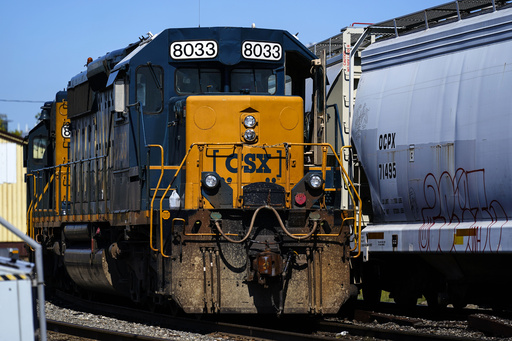Major freight railroads will have to maintain two-person crews on most routes under a new federal rule that was finalized Tuesday in a milestone in organized labor’s long fight to preserve the practice.
The Transportation Department’s Federal Railroad Administration released the details of the rule that was first proposed during former President Barack Obama’s administration. Out of more than 13,000 comments on the rule, about 60 opposed it.
There has been intense focus on railroad safety since a fiery February 2023 derailment in Ohio, but few significant changes have been made apart from steps the railroads pledged to take themselves and the agreements they made to start providing paid sick time to nearly all workers. Such changes include adding hundreds more trackside detectors and tweaking how to respond to alerts from them. A railroad safety bill proposed in response to the derailment has stalled in Congress.
Rail unions have long opposed one-person crews because of safety and job concerns. Labor agreements requiring two-person crews have been in place for roughly 30 years at major railroads, although many short-line railroads already operate with one-person crews without problems. The unions say that conductors are crucial in helping operate the train and keeping engineers alert, and that they serve as first responders.
“As trains — many carrying hazardous material — have grown longer, crews should not be getting smaller,” said Eddie Hall, the president of the Brotherhood of Locomotive Engineers and Trainmen union. He praised the FRA for taking the step President Joe Biden promised. Hall said keeping two people in the cab of a locomotive is crucial now that railroads rely on longer trains that routinely stretch for miles.
Transportation Secretary Pete Buttigieg said the U.S. shouldn’t accept the current average of nearly three derailments a day, and that regulators will keep fighting to improve that record.
“When good safety rules have been put in place over the years, especially after high-profile incidents, we see derailments come down on mainline tracks. But as attention faded on those incidents, the railroad industry lobby was consistently able to weaken or delay important safety provisions,” Buttigieg said at a news conference.
Railroads have a history of resisting new regulations as they sought the discretion to operate trains with only one person and to move conductors to ground-based jobs in places with automatic braking systems. Conductors in a truck would respond to train problems and derailments in a certain territory. It has been a key issue in contract talks for years, though the railroads abandoned the proposal just as the 2022 negotiations approached a strike.
The railroads argue that the size of train crews should be determined by contract talks, not regulators or lawmakers, because they maintain there isn’t enough data to show that two-person crews are safer. The norm on major railroads is two-person crews, so current safety statistics reflect that reality. The industry pointed out that the FRA abandoned the original version of this rule during the administration of former President Donald Trump, with the agency saying in 2019 that there wasn’t enough evidence to support it.
“FRA is doubling down on an unfounded and unnecessary regulation that has no proven connection to rail safety,” said Ian Jefferies, president and CEO of the Association of American Railroads trade group.
The East Palestine, Ohio, derailment put a national spotlight on rail safety because of the consequences of the hazardous chemicals that spilled and caught fire, forcing thousands of residents to evacuate and causing lingering health concerns.
Investigators haven’t suggested the crew on that train did anything wrong. And it actually included three people because there was a trainee aboard. The National Transportation Safety Board has said the derailment was likely caused by an overheating wheel bearing that wasn’t caught in time by sensors.
U.S. Sen. Sherrod Brown, an Ohio Democrat, said it’s still important to pass a rail safety bill he cosponsored along with several Republicans because it would ensure future administrations couldn’t drop the crew-size rule and would make other meaningful improvements, including standards for trackside detectors and railcar inspections. Brown said he wants to ensure “no community ever has to suffer like East Palestine did.”
The worst railroad disaster in recent history involved a one-person crew. In 2013, the brakes failed on a train parked in the hills above the Canadian town of Lac-Megantic. The train rolled downhill and derailed, killing 47 people and causing millions of dollars in damage.
Another fiery derailment outside Casselton, North Dakota, in 2013 demonstrated some of the benefit of having a conductor aboard the train. The conductor helped separate undamaged tank cars filled with crude oil from the rest of the train so they could be pulled away from the fire.
At least 11 states have already approved rules requiring two-person crews. States frustrated with the federal government’s reluctance to pass new regulations on railroads have also tried to pass restrictions on train length and blocked crossings.
The industry often challenges the state rules in court, though with this new federal rule it’s not clear whether the railroads will resort to that tactic. The railroads generally argue in their state lawsuits that the federal government should be the only one to regulate the industry to ensure a uniform set of rules, and they wouldn’t be able to make that argument in a challenge to the federal rule.
This website uses cookies so that we can provide you with the best user experience possible. Cookie information is stored in your browser and performs functions such as recognising you when you return to our website and helping our team to understand which sections of the website you find most interesting and useful.
